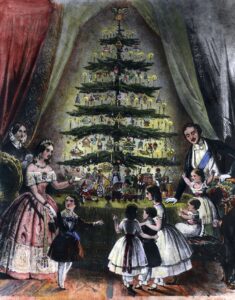Like many people around the world, members of the British Royal Monarchy celebrate Christmas with their loved ones. However, many exciting historical events are connected with the Christmas holidays in the Royal family history. Let’s have a look at a few of them.
25 December 1066 – The Duke of Normandy William I was crowned King of England in Westminster Abbey. It was a crucial moment for England because the Anglo-Saxon culture, gradually replaced by the Normans and then French culture, began to decline.
25 December 1264 – King Henry III decided to spend the Christmas holidays at his residence Woodstock Palace. Christmas was one of the most important holidays in the Middle Ages, with many spectacular feasts. And since it was expensive to feed farm animals in winter, most of them were killed, so the feast could be even more impressive. On this day, the festivities held in King Henry III’s backyard contained 30 pieces of cattle, 100 sheep, 5 wild boars, 9 dozen chicken, salted venison from Wiltshire, salmon and lampreys from Gloucester, 6 tons of wine from Bristol and 13 from Northampton.

1561 – Misrule, feasts held during Easter, Labor Day, Holy Days, and summer solstice were celebrated in the Elizabethan Golden Age. The most eccentric celebrations occurred during the “Twelfth Night,” i.e., on the twelfth day after Christmas. The Misrule looked like total anarchy because all the traditional rules were broken during the celebrations: men dressed as women, court jesters, became kings, and servants became masters. After all, Queen Elizabeth abolished this tradition because she did not like the disturbance of public order the celebrations used to cause.
25 December 1714 – In 1714, George I became the new British ruler, the first of the German house of Hanover (Queen Victoria was the last of this family). The king faced a great challenge, as he did not know much about the new homeland and did not speak English very well. That is why his subjects and the royal court began to distrust him. Nevertheless, a popular legend, which talks about how the king first tasted the traditional Christmas “Plum Pudding” during his first Christmas on the island, spread during this time. Since then, he has been nicknamed the “Pudding King.”.”
1790 – When did the first Christmas tree actually come to Great Britain? Queen Charlotte, the wife of King George III, plays an important role in that. Decorated trees, which gave Christmas a magical dimension, are of German origin. They became popular in the Protestant community. The queen herself came from a German family, and so it went naturally hand in hand. However, they were not typical trees as we know them today. In the 18th century, people used to decorate yew branches.
1857 – While Queen Charlotte once established the tradition of using Christmas branches, Queen Victoria and her family who popularized the Christmas trees as we know them today and many other traditions associated with Christmas. Prince Albert, Queen Victoria’s husband, wanted to bring a piece of the German homeland to Christmas, so he decided to have a few trees placed at Windsor Castle, with the largest one in the middle. Together with their children, they decorated them with sweets and candles. The general public enjoyed the photographs of the royal family around the Christmas tree. So everyone at home wanted a tree like Queen Victoria.
25 December 1932 – on this day, for the first time, a live Christmas speech by a royal family member was delivered. It was George V., the grandfather of the recently deceased Elizabeth II. Although the king was not happy with the speech, he was persuaded by the argument that it would please his people. In the end, connecting with ordinary people might have helped him like his subjects. When he celebrated the silver jubilee, he commented on his popularity: “I don’t understand it; after all, I’m just a very ordinary person.”

25 December 1950 – When King Edward I dethroned Scottish monarch John Balliol in 1296, he also took from Scotland the legendary “Stone of Scone,” a rectangular block of red sandstone that served for centuries during the coronation of monarchs. Eduard I brought him to Westminster Abbey, where he was placed under the so-called “Coronation Chair,” a ceremonial wooden chair still in use during coronations. However, on Christmas 1950, the stone mysteriously disappeared. It was stolen by Scottish nationalists and not only the stone but also the wooden stool, unfortunately, partially damaged. The stone was eventually recovered and reused in the coronation of Elizabeth II in 1953. It returned to Scotland after long centuries, only in 1996, when it was temporarily placed in Edinburgh Castle. It should be brought back at King Charles III’s coronation.
25 December 2021 – People worldwide had the opportunity to listen to Queen Elizabeth II’s last Christmas speech. Despite the old age and difficulties associated with the covid crisis and especially with the loss of her husband, Prince Philip, in the spring of the same year, people hoped that their favorite monarch would stay with them for a longer time. She spoke to people for the first time after the death of her father, King George VI. On Christmas in 1957, the spectators could also see her live on TV broadcast from the royal seat in Sandringham.
Text: MS, source: www.royal.uk, photo: adobe.stock.com, www.webstermuseum.org













